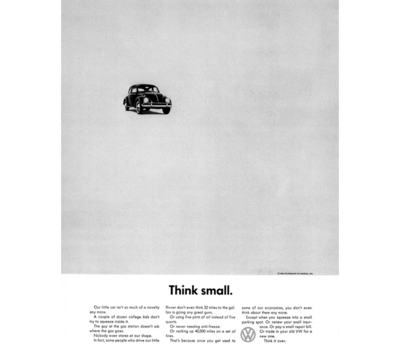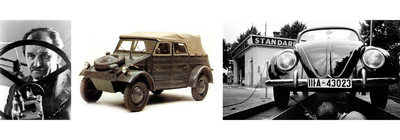A Look Back: Volkswagen - A Summary History of Trials, Tribulations and Triumphs +VIDEO
By Marty Bernstein
AIADA Contributing Editor
Every history, even a summary history, must have a beginning, a starting point if you will, of what will be-come a passing parade of events, dates, people and, in this instance, vehicles. This summary is no different, but does try to limit the length of the parade. Sometimes, there’s just too much information.
The Early Years -- the 1930’s
The time: sixty-nine years ago, May 28th, 1937. The place: Germany. The event: Automotive history was made with the founding of a new automobile company, the Gesellschaft zur Vorbereitung des Deutschen Volkswagens mbH, that, a little over a year later, became Volkswagenwerk GmbH. Thus began the formal story of Volkswagen.
For many this date, indeed this event, marked the end of Germany’s World War I economic depression, but for many it was the beginning a very dark time. The clouds of World War II were forming, the subjugation and subsequent murder and death of tens of millions was only months away.
According to unimpeachable sources, the real history of the Volkswagen began a few years earlier, on February 11, 1933. That is when Adolf Hitler, the new Chancellor of Germany made his first public speaking appearance at the Berlin Auto Show. Before a crowd of auto executives and the media (somethings never change do they?), Hitler revealed his plan for the “motorization” of Germany. The linchpins of this plan were construction of the first superhighway, the autobahn, and the idea of a new affordable car for everyone.
Almost simultaneously, a talented German automotive designer, Ferdinand Porsche, was designing and building a prototype of an inexpensive, odd looking, yet sleek design, rear engine, air cooled, little vehicle that could hold five people.
Porsche and Hitler had fateful meetings in 1933 and 1934, with Porsche promising to deliver proto-types within the year. Three handmade cars were delivered for testing and 30 more were built by Mercedes-Benz two years later.
Then in 1938, after testing was approved building began for a new factory to manufacture the new Volkswagens. But in fact, few were produced; rather, military vehicles which included the Kubelwagen – literally, the German Jeep – was built in the new factory by slave labor. These vehicles did not carry the now famous VW circle logo with the V resting inside the W; they were known as KdF, the acronym for the German slogan, kraft durch freude, which means strength through joy.
The War Is Over, Rebuilding Begins – the 1940's
During WWII, the factory, a source of military vehicles, was obviously a prime target for Allied bombers and did sustain heavy damage, but surprisingly was not destroyed. After the war was over, the British Army took control of the damaged factory under the supervision of Major Ivan Hirst. Under his watch, machines were rebuilt and repaired, the line reestablished, and the factory was brought up to speed. In an amazing feat of accomplishment, 2,000 vehicles were built in 1945 from parts found in the factory’s rubble.
The following year, the Brit’s had pushed production up to 10,000 vehicles, renamed the company Volkswagen, and gave the factory town the name Wolfsberg, which was taken from the name of a local castle.
But in typical end-of-war attitude, the British wanted to get out of the automobile business and sought to give control of the company to a qualified company. And here’s where it gets really interesting…
Among those astute companies who turned down the open offer to take control of the company was the Ford Motor Company, who thought it would be a money drain. The French government gave an emphatic “mai no,” as did a long-gone British auto company, even Fiat said they’d pass.
Bottom line? They could not give away the company to a going business. So, in 1949, they gave the whole kit and caboodle to the new German government in trust.
With a new vigor and commitment, aided in part by the U.S. Marshall Plan, VW became a viable growing business. Factory improvements were made, new models were introduced (including, the Transporter aka the VW Bus), sales in Germany grew, exports to other European nations were developed, production steadily increased and new workers were hired. Life was getting good.
Then, in 1949, the first VW’s were imported to the U.S. by an entrepreneur named Ben Pon, unfortunately, with little success. The reasons were many: American’s did not want a car that looked like a bug, the vehicle made a lot of noise, did not have a synchromesh transmission, much less chrome trim, nor did it have a radio or gas gauge, it wasn’t heated, and similar to Ford’s “Tin Lizzie,” it was only available in one color, grey. Sales were nil, partially due to a still lingering anti-German sentiment following the war. Big was better, bolder and more beautiful. American brands were the ranking royalty.
Those Fantastic, Fabulous Days – The 1950’s in America
Undaunted by its initial lack of success, Volkswagen made another effort in the early ‘50’s to sell in the U.S. market teaming up with the Hoffman Company, which began to import Volkswagen Beetles to America.
This second attempt again resulted in little success, despite the fact a new export model had been introduced with chrome trim, various colors were available, as was a radio and manifold heater, but it still lacked a gas gauge. It did have a minuscule reserve tank, which was manually operated to switch from the regular tank when empty.
It was in the mid-fifties that America and Americans underwent a significant change. It was a change in attitudes, mores, entertainment, customs and former habits that led to the enjoyment of peacetime and a vibrant economy. Times were good, even amid the Cold War and the Iron Curtain. The move to the suburbs had begun, the first shopping center was built, a college education was no longer unusual, the Dow Jones was in the low hundreds, the low hundreds!
What is now called the Golden Age of Television – great variety, drama, kids shows and westerns – was underway on black and white sets, without remote controls. Limited broadcasts in color began in 1953. The NFL was barely mentioned on sports pages, baseball was king of sports broadcasting, boxing came in at a close second. The news lasted just 15 minutes. Presidential press conferences were not televised. Elvis cut his first Sun Record and rock and roll began. Broadway introduced musicals that still appear today.
It was a period of consumer innovation and invention. Bell Labs created the first telephone answering machine, Super Glue came to the market, the double helix of DNA was discovered, the ubiquitous bar code, Velcro, the remote control and birth control pills were patented, the hula hoop was introduced, and man walked on the moon.
Cars were more than a mode of transportation; Detroit proffered, presented and promoted them as a means of communicating status, wealth, position, and comfort albeit with tailfin design excess. The Edsel was introduced, as was power steering and radial tires.
But it was also the beginning of non-conformity to an egalitarian norm. Sputnik beat America to space. The first Beatniks appeared on college campuses. Dirty books were no longer dirty, they were best selling, Pulitzer prize winning novels or books of poetry. Art was paintings of soup cans and splashes of paint.
Then suddenly, almost miraculously and without any advertising, VW’s started to sell; first in college towns, then in a few major metro areas. Sales jumped from 2,000 units in 1953 to 150,000 in 1959.
Who was buying Beetles? Trendsetters (early adapters we’d call ‘em today), iconoclasts, college professors and recent grads and people who demanded value, quality and function over style, design and perceived image.
The VW business was better than good in Germany, it was booming, which was a boon to the West German economy that heavily relied on exports. Beetle’s, as they were then called, were being sold in Denmark, Sweden, Luxembourg, Belgium, Switzerland and the UK. New factories had been built in South Africa and Brazil to meet the growing demand.
Then, in late 1959, Volkswagen decided to hire an advertising agency and …
Automotive and Advertising History is Made – The 60’s
A little known, New York advertising agency, Doyle Dane Bernbach (DDB), whose claim to fame was a few ads they had created for the opening of a VW dealer on Long Island, and a handful of unique ads created by a Jewish owned agency for primarily Jewish clients – Orbach’s, a discount department store, Levy’s Rye Bread, El Al Airlines – won the Volkswagen account over more traditional ad agencies.
A German company and a Jewish agency…conventional wisdom said, this was not a match, much less a marriage made in heaven. But this was not a conventional agency or a conventional client. The non-conformist VW executive in America who made this momentous decision was Carl Hahn, a man who several years later gained a Ghosn-like reputation and stature.
Most automotive print advertising in those days was an imagined expression of what car companies and their ad agencies thought the world, automobiles and the people who owned and drove the specific brand should look like.
Stretch it. Imagine, indeed invent a lovely situation and venue. Show beautiful people doing wonderful things in stylish, scenic or bucolic surroundings, and of course, all while they’re next to a car. Reality be damned. Look at All American Ads - 60’s edited by Jim Heimann and published by Taschen, you’ll see I’m not exaggerating.
To the 50’s automotive advertising world of splashy colors, exaggerated drawings, paintings and renderings of vehicles that were married to dreary copy, laden with facts and clichés as well as features and perceived benefits, Doyle Dane brought not just freshness, but they invented a new form of advertising. One that is alive and thriving today.
But then they had to. VW in the ‘60’s was essentially unknown. Those who had read or heard about the company knew it was German, the car inspired by Hitler, was founded to make cars for the Germans, using slave and concentration camp labor to build military vehicles during the war.
This was not a minor obstacle to overcome or surmount back then as resentment still smoldered from WWII. So, how did DDB overcome this impediment to success?
In a stroke of marketing super-genius … they ignored it! That’s right, not one VW ad from DDB ever spoke of its German heritage, history and association. The brand was literally invented in America in 1960 by the advertising – primarily print – at the time. There was no historical frame of reference ever. Contrast that with today, when German automotive heritage is a highly valued expression of excellence.
The assets and attributes of the Beetle were simple: It was a cute (some called it an ugly car), well-made, durable little car that was inexpensive and represented a good value. The ads DDB created used these facts to create conversations with consumers that never used the words themselves, just the concepts.
DDB was the first agency to use a creative team of writers and art directors, in most agencies the functions were separate. Teams of exceptional talents worked seamlessly to create amazing advertising. Even today, these Volkswagen Advertising Hall of Fame ads would still stand out and cut through the clutter. Just click on these links:
AIADA Presents - Chapter 3 How Free Trade Policy Impacted the U.S. Auto Industry"




